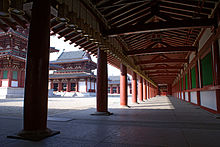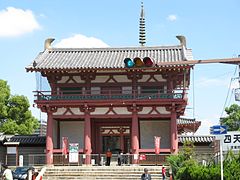Shitennō-ji
Shitennō-ji ( Japanese 四 天王寺 ) is a Buddhist temple in the Japanese city of Osaka in the district of Tennōji-ku named after him . It belonged temporarily to Tendai Buddhism , but has been an independent temple since 1946, which, in reference to its founding time, represents a position that spans the Buddhist schools.
history
The establishment of Shitennō-ji in 593 is attributed to Prince Shōtoku , when Osaka was still called "Naniwa" ( 難 波 ). Kongō Gumi is said to have been involved in the construction . In addition to the short name Tennō-ji ( 天王寺 ), the temple was also called Arahaka-ji ( 荒 陵 寺 ), Naniwa-daiji ( 難 波 大寺 ), Mitsu-ji ( 御 津 寺 ) or Horie-dera ( 堀 江 寺 ) in ancient times . When the temple was founded, there were four social institutions:
- Keiden-in ( 敬 田 院 ), education department,
- Hiden-in ( 悲 田 院 ), welfare department,
- Seyaku-in ( 施 薬 院 ), remedies department,
- Ryōbyō-in ( 療 病院 ), nursing department.
The name of the temple refers to the Four Kings of Heaven, who - like in other temples - surround the altar ( 須弥 壇 , Shumidan ). The temple complex with a total extension of originally 11 hectares was often destroyed in the course of history by fire, typhoons and also civil war, but was rebuilt again and again according to the old pattern. After extensive destruction towards the end of the Second World War, the temple has been rebuilt in the old style since the 1960s, but this time out of concrete. Even so, this temple is a good example of the architecture of the Asuka period .
Inner temple district
The temple district (A) follows the pattern adopted from China:
- Coming from the south through the “Middle Gate” (a) ( Chūmon ), the visitor passes a passage that surrounds the central complex on the outside in the form of a rectangle. The pillars of the gallery show a bulge ( entasis ), typical for the time. The Chūmon is also called "Niōmon" after the two temple guards Niō ( 仁王 ) who flank the entrance. At 5,3 m, they are the second largest in Japan after those in Tōdai-ji . Its creator is priest Matsuhisa Hōrin (1901-1987), who created it according to old models.
Then follow:
- the pagoda (b), five-story ( Gojū-no-tō ) with a height of 29.2 m,
- the main building (c) ( Kondō ), in the style of the first building, with the seated "Kyūsei Kanseon Bosatsu",
- the teaching hall (d) ( Kōdō ), integrated into the north wing, with Amida Nyorai.
The other buildings belonging to the "Seven Building Temple District " ( Shichidō-garan ), sutras ( Kyōzō ), bell tower ( Shōrō ), monks' quarters ( Sōbō ) and dining room ( Shikidō ), as well as here mostly a drum tower ( Taikorō ), are or were in the outer temple precinct.
Outer temple precinct
Coming from the south you enter the temple area through the Great South Gate Nandaimon (4), which has been rebuilt in recent years. Coming from the west you pass the preserved stone torii (1) and the rebuilt Gorakumon (2) and then pass through the west gate into the inner temple area. In the east of the outer district there is a separate area ( Seirei-in ) dedicated to Prince Shōtoku, the Taishiden, which consists of Zenden (7) and the octagonal Okuden (8), both of which have also been rebuilt. In the Seirei-in there is also the Sutrenspeicher (not marked on the map).
Gallery of rebuilt buildings
Gallery of preserved buildings and facilities
In the outer temple area there are some buildings that survived the World War and that are registered as important cultural assets :
View through the preserved stone torii (1) from 1294 onto the Gokurakumon (2).
Side temple Gansandō, within the cemetery (C), dedicated to Gansan .
Other facilities
The temple treasures are displayed in the Hōmotsukan Museum (M). The Shitennōji gakuen (S) school is also located on the premises.
Access
There is an entrance fee to visit the inner temple district, the abbot's quarter and the museum.
Remarks
- ↑ Jikoku-ten ( 持 国 天 ) watches in the east, Zōjō-ten ( 増 長 天 ) in the south, Kōmoku-ten ( 広 目 天 ) in the west and Tamon-ten ( 多 聞 天 ) in the north . Since the temple complex is oriented to the south and Tamon-ten would stand behind the altar, the Heavenly Kings are placed diagonally with the Tamon-ten in the northeast.
- ↑ At the top of the torii there is a bronze plaque (hengaku) 1.5 m high from the year 1326. Its Buddhist inscription reads 「釈 迦 如 来 転 法輪 処 当 極 楽 土 東門 中心」 .
literature
- Leaflet of the temple (Japanese, English)
Web links
- Temple website (Japanese)
Individual evidence
Coordinates: 34 ° 39 ′ 14 " N , 135 ° 30 ′ 59" E

















